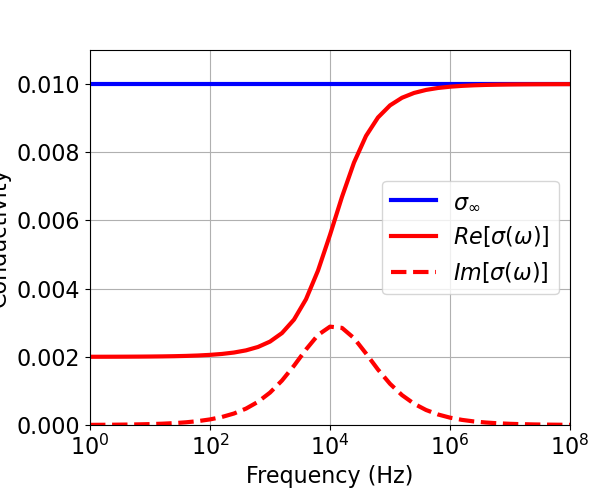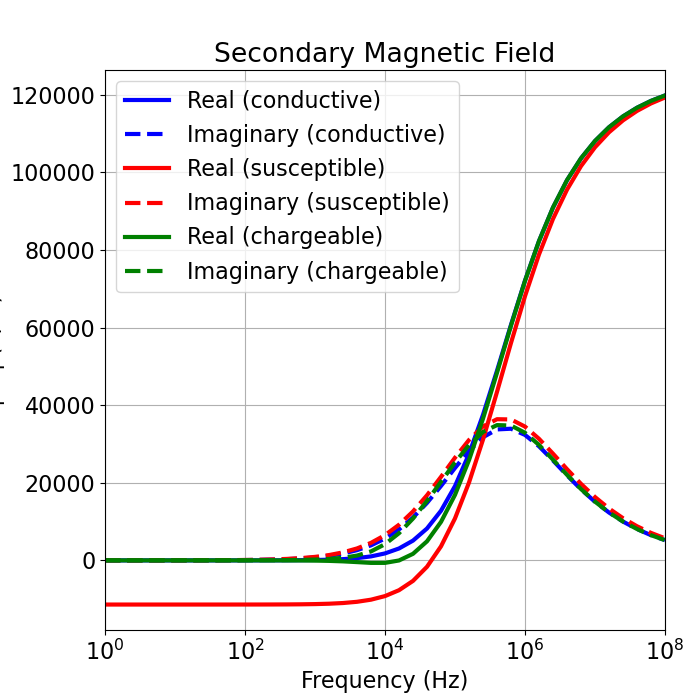Note
Click here to download the full example code
1D Forward Simulation for a Susceptible and Chargeable Earth#
Here we use the module SimPEG.electromangetics.frequency_domain_1d to compare predicted frequency domain data for a single sounding when the Earth is purely conductive, conductive and magnetically susceptible, and when it is chargeable. In this tutorial, we focus on:
Defining receivers, sources and the survey
Defining physical properties when the Earth is chargeable and/or magnetically susceptibility
Setting physical property values as constant in the simulation
Our survey geometry consists of a vertical magnetic dipole source located 30 m above the Earth’s surface. The receiver is offset 10 m horizontally from the source.
Import Modules#
import numpy as np
from matplotlib import pyplot as plt
from SimPEG import maps
import SimPEG.electromagnetics.frequency_domain as fdem
from SimPEG.electromagnetics.utils.em1d_utils import ColeCole
plt.rcParams.update({"font.size": 16})
# sphinx_gallery_thumbnail_number = 2
Create Survey#
Here we demonstrate a general way to define the receivers, sources and survey. For this tutorial, the source is a vertical magnetic dipole that will be used to simulate data at a number of frequencies. The receivers measure real and imaginary ppm data.
# Frequencies being observed in Hz
frequencies = np.logspace(0, 8, 41)
# Define a list of receivers. The real and imaginary components are defined
# as separate receivers.
receiver_location = np.array([10.0, 0.0, 10.0])
receiver_orientation = "z" # "x", "y" or "z"
data_type = "ppm" # "secondary", "total" or "ppm"
receiver_list = [
fdem.receivers.PointMagneticFieldSecondary(
receiver_location,
orientation=receiver_orientation,
data_type=data_type,
component="both",
)
]
# Define a source list. A source must defined for each frequency.
source_location = np.array([0.0, 0.0, 10.0])
source_orientation = "z" # "x", "y" or "z"
moment = 1.0 # dipole moment
source_list = []
for freq in frequencies:
source_list.append(
fdem.sources.MagDipole(
receiver_list=receiver_list,
frequency=freq,
location=source_location,
orientation=source_orientation,
moment=moment,
)
)
# Define a 1D FDEM survey
survey = fdem.survey.Survey(source_list)
Defining a Layered Earth Model#
Here, we define the layer thicknesses and physical properties for our 1D simulation. If we have N layers, parameters for the physical properties must be defined for each layer and we must provide N-1 layer thicknesses. The lowest layer is assumed to extend to infinity.
For this tutorial, we predict the response for a halfspace model, however the script has been generalized to work for an arbitrary number of layers. If the Earth is a halfspace, the thicknesses could instead be defined by an empty array, and each physical property value by an array of length 1.
# Layer thicknesses
thicknesses = np.array([20, 40])
n_layer = len(thicknesses) + 1
# In SimPEG, the Cole-Cole model is used to define a frequency-dependent
# electrical conductivity when the Earth is chargeable.
sigma = 1e-2 # infinite conductivity in S/m
eta = 0.8 # intrinsice chargeability [0, 1]
tau = 0.0001 # central time-relaxation constant in seconds
c = 0.8 # phase constant [0, 1]
# Magnetic susceptibility in SI
chi = 0.2
# For each physical property, the parameters must be defined for each layer.
# In this case, we must define all parameters for the Cole-Cole conductivity
# as well as the magnetic susceptibility.
sigma_model = sigma * np.ones(n_layer)
eta_model = eta * np.ones(n_layer)
tau_model = tau * np.ones(n_layer)
c_model = c * np.ones(n_layer)
mu0 = 4 * np.pi * 1e-7
mu_model = mu0 * (1 + chi) * np.ones(n_layer)
# Here, we let the infinite conductivity be the model. As a result, we only
# need to define the mapping for this parameter. All other parameters used
# to define physical properties will be fixed when creating the simulation.
model_mapping = maps.IdentityMap(nP=n_layer)
# Plot complex conductivity at all frequencies
sigma_complex = ColeCole(frequencies, sigma, eta, tau, c)
fig = plt.figure(figsize=(6, 5))
ax = fig.add_axes([0.15, 0.15, 0.8, 0.75])
ax.semilogx(frequencies, sigma * np.ones(len(frequencies)), "b", lw=3)
ax.semilogx(frequencies, np.real(sigma_complex), "r", lw=3)
ax.semilogx(frequencies, np.imag(sigma_complex), "r--", lw=3)
ax.grid()
ax.set_xlim(np.min(frequencies), np.max(frequencies))
ax.set_ylim(0.0, 1.1 * sigma)
ax.set_xlabel("Frequency (Hz)")
ax.set_ylabel("Conductivity")
ax.legend(
["$\sigma_{\infty}$", "$Re[\sigma (\omega)]$", "$Im[\sigma (\omega)]$"],
loc="center right",
)
plt.show()

Define the Forward Simulation and Predict Data#
Here we predict the FDEM sounding for several halfspace models (conductive, susceptible, chargeable). Since the physical properties defining the Earth are different, it requires a separate simulation object be created for each case. Each simulation requires the user define the survey, the layer thicknesses and a mapping.
A universal mapping was created by letting sigma be the model. All other parameters used to define the physical properties are permanently set when defining the simulation.
When using the SimPEG.electromagnetics.frequency_domain_1d module, note that predicted data are organized by source, then by receiver, then by frequency.
# Response for conductive Earth
simulation = fdem.Simulation1DLayered(
survey=survey, thicknesses=thicknesses, sigmaMap=model_mapping
)
dpred = simulation.dpred(sigma_model)
# Simulate response for a conductive and susceptible Earth
simulation_susceptible = fdem.Simulation1DLayered(
survey=survey, thicknesses=thicknesses, sigmaMap=model_mapping, mu=mu_model
)
dpred_susceptible = simulation_susceptible.dpred(sigma_model)
# Simulate response for a chargeable Earth
simulation_chargeable = fdem.Simulation1DLayered(
survey=survey,
thicknesses=thicknesses,
sigmaMap=model_mapping,
eta=eta,
tau=tau,
c=c,
)
dpred_chargeable = simulation_chargeable.dpred(sigma_model)
Plotting Results#
fig = plt.figure(figsize=(7, 7))
ax = fig.add_axes([0.15, 0.1, 0.8, 0.8])
ax.semilogx(frequencies, dpred[0::2], "b-", lw=3)
ax.semilogx(frequencies, dpred[1::2], "b--", lw=3)
ax.semilogx(frequencies, dpred_susceptible[0::2], "r-", lw=3)
ax.semilogx(frequencies, dpred_susceptible[1::2], "r--", lw=3)
ax.semilogx(frequencies, dpred_chargeable[0::2], "g-", lw=3)
ax.semilogx(frequencies, dpred_chargeable[1::2], "g--", lw=3)
ax.set_xlim([frequencies.min(), frequencies.max()])
ax.grid()
ax.set_xlabel("Frequency (Hz)")
ax.set_ylabel("|Hs| (A/m)")
ax.set_title("Secondary Magnetic Field")
ax.legend(
(
"Real (conductive)",
"Imaginary (conductive)",
"Real (susceptible)",
"Imaginary (susceptible)",
"Real (chargeable)",
"Imaginary (chargeable)",
)
)

<matplotlib.legend.Legend object at 0x7feeda7bb7d0>
Total running time of the script: ( 0 minutes 2.762 seconds)
Estimated memory usage: 18 MB